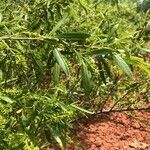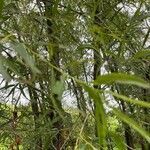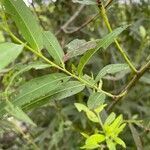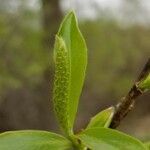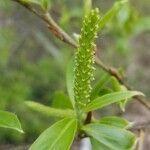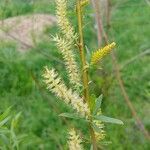Trees, 5-20+ m. Stems: branches highly brittle at base, red-brown to yellow-brown, glabrous; branchlets gray-brown to red-brown, glabrous or pilose to villous. Leaves: stipules rudimentary or foliaceous on early ones, usually foliaceous on late ones, (glands few or absent adaxially), apex acuminate, acute, or rounded; petiole (margins covering groove, with spherical glands distally), (2-)3-10(-15) mm, glabrous or pilose adaxially; largest medial blade (sometimes amphistomatous), very narrowly elliptic, lanceolate to narrowly lanceolate, or linear to lorate, (50-)70-103(-190) × (6-)7.5-17(-23) mm, 6-13 times as long as wide, base cuneate to convex, margins serrulate, apex acuminate, acute, or caudate, abaxial surface (not glaucous), glabrous or pilose, hairs white or ferruginous, wavy, adaxial slightly glossy, glabrous or pilose (especially on midribs); proximal blade margins serrulate; juvenile blade glabrous or pilose abaxially, hairs white and/or ferruginous. Catkins: staminate 35-83 × 7-13 mm, flowering branchlet 5-35 mm; pistillate 23-74(-80 in fruit) × 5-10 mm, flowering branchlet 6-35 mm; floral bract 1-3 mm, apex acute or rounded, entire, abaxially sparsely hairy, hairs wavy; pistillate bract deciduous after flowering. Staminate flowers: abaxial nectary 0.3-1 mm, adaxial nectary oblong to ovate, 0.2-0.6 mm, nectaries distinct or connate and shallowly cup-shaped; stamens 4-6; filaments hairy on proximal 1/2 or basally; anthers 0.4-0.6 mm, (axes strongly recurved). Pistillate flowers: adaxial nectary oblong, (swollen), 0.2-0.5 mm; stipe 0.5-1.5 mm; ovary pyriform to obclavate, (rarely pilose), beak slightly bulged below styles; ovules 12-16 per ovary; styles 0.1-0.3 mm; stigmas (sometimes 2 plump lobes), 0.2-0.28-0.36 mm. Capsules 3-5 mm. 2n = 38.
More
Shrub or tree to 20 m or more, with 1–4 often leaning trunks to 5 dm thick; twigs slender, yellowish-brown to dark reddish-brown, often hairy when young; buds sharp-pointed, the scale with overlapping free margins; stipules usually well developed, to 12 mm, semicordate, acute, serrulate, often deciduous; lvs commonly pendulous, lance-linear or narrowly lanceolate, 6–10(–12) × 1–1.5(–2) cm, long-acuminate, often falcate, finely serrulate, the upturned lateral veins forming a continuous marginal vein, deep green above, paler beneath (but not or scarcely glaucous) and with very small areoles, often hairy when young; petioles 4–10 mm, usually hairy, commonly glandular at the tip; catkins with the lvs, slender, lax, 2.5–7 cm, on leafy peduncles 1–3 cm; scales yellowish, villous, deciduous; stamens (3–)6(7); fr ovoid-conic, 3–5 mm, glabrous; pedicels 0.5–1.5 mm; style 0.2 mm; 2n=38. Abundant in alluvial soil along streams and in meadows; s. N.B. to c. Minn., s. to Fla. and Tex., and w. across s. U.S. to Calif., s. into Mex. Ours is var. nigra. (S. marginata)
A large tree. It loses its leaves during the year. It grows 12-30 m high. The trunk is 30-80 cm across. The bark is scaly and often becomes rough. Young branches have scars from where twigs fell off. The leaves are narrow and sword shaped. There are very small teeth along the edge. The leaves are green on both surfaces. The flowers are separately male and female in catkins. The male catkins are 2-5 cm long.
Found in a wide variety of wet soils, growing on floodplains, edges of ponds and lakes, swamps, marshes, white cedar bogs, wet meadows, open fields, roadside ditches, mixed upland deciduous woods along streams; at elevations up to 1,400 metres.
More
It is a temperate plant. Trees cannot tolerate shade. It grows to 1,500 m altitude in the southern USA. It suits hardiness zones 4-10.
